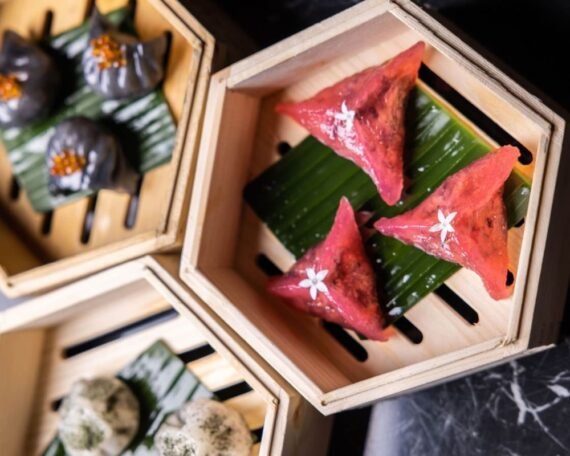Love the idea of DIY dumplings, but a little intimidated to tackle the task? These at-home dumpling tips by Executive Head Chef Dario Nencioni at modern-Asian fusion restaurant Luna Lu will have you perfecting your potstickers in no time!
First time folding? Dough’nt stress
The key to perfect dumplings starts with the dough. The main ingredients you’ll need are simple: all-purpose flour, water, and a pinch of salt (optional). For a more tender, softer dough, Chef Nencioni suggests using hot water, especially if you’re planning to steam your dumplings. For boiled or pan-fried dumplings, cold water results in a firmer, chewier texture. A typical ratio for the dough is two cups of flour to two-thirds cup of water.
To achieve the right dough consistency, knead for about 10-15 minutes until smooth and elastic. “Letting the dough rest for 30 minutes is crucial,” Nencioni advises. “This allows the gluten to relax, making the dough easier to roll out.” Aim to roll the dough as thin as possible without tearing it—this ensures a nice balance between the wrapper and the filling.
Filling options: Go classic … or get creative!
While traditional fillings like pork and prawn are classics for a reason, Nencioni encourages creativity. He loves using a blend of pork, prawn, ginger, garlic, and chives for a punchy flavor, but also recommends a vegetarian mushroom and spinach combo for a lighter bite.
For a more adventurous take, Nencioni suggests trying Fremantle octopus with black garlic and herbs. “This adds an oceanic twist to your dumplings,” he says. The secret to a well-balanced filling? Always taste your filling before wrapping to ensure it’s seasoned with the perfect balance of salt, umami, and acidity.
Simple techniques for sealing success
Shaping your dumplings is where the fun – and sometimes frustration – begins. Nencioni prefers the traditional pleated fold, which seals well and adds an appealing visual element. “For beginners, keep it simple,” he advises. “Press the edges together tightly to avoid leaks.”
Overfilling is one of the most common mistakes home cooks make. It’s tempting to stuff as much filling as possible, but too much can cause the dumplings to burst during cooking. Another rookie mistake? Rolling the dough too thick. “Thicker dough can make the dumplings chewy,” warns Nencioni, so aim for a delicate, thin wrapper for a perfect bite.

Steamed, boiled or fried? Mastering cooking methods
When it comes to cooking, Nencioni has a method for every mood. “I love pan-frying for that perfect combination of crispy and tender,” he shares. For pan-fried dumplings, start by frying them in hot oil until the bottoms are crisp. Then, add a splash of water, cover the pan, and let the dumplings steam through. Once the water evaporates, you’ll be left with a beautifully crisp crust.
If you prefer a softer bite, steaming is the way to go, while boiling delivers a firmer texture. “It’s all about the texture you want,” Nencioni explains.
Serving suggestions
A good dipping sauce can make or break a dumpling, and Nencioni has a few favorites. “I love a mix of soy sauce, rice vinegar, and chili oil,” he says. For something a little different, he recommends ponzu with a dash of sesame oil for a tangy, nutty flavor.
To elevate your dumpling game, try garnishing with fresh herbs like coriander, or adding a sprinkle of toasted sesame seeds or crispy shallots. Pair your dumplings with a side of pickled vegetables or a light broth for a more complete meal. And if you have any leftover dough or filling? Nencioni suggests repurposing the dough for homemade noodles or using the filling for meatballs or stuffing vegetables.
Final tips to wrap (or roll) things up
For anyone looking to perfect their dumpling-making skills, Nencioni’s top three tips are: 1) Don’t overfill your dumplings, so they seal properly. 2) Keep the dough soft but not sticky for easier handling. 3) Always taste your filling before wrapping to ensure it’s well-seasoned.
As for tools, a good rolling pin is essential for even wrappers, and a bamboo steamer will give you consistent results. For those hesitant to take the plunge into DIY dumpling-making, Nencioni offers the reassurance that you win some (or dim sum?) you lose some – but that that shouldn’t deter your from attempting to DIY at home dumplings. “Dumplings are forgiving! Start simple, focus on sealing them well, and have fun with the process. You’ll improve with each batch.”








